Throughout the ranks of small punters runs a thread of doubt regarding the honesty of Australian racing.
This nagging doubt is an ever-presence and measurably affects the average punter's assault on the TAB - in many ways, and often at considerable cost.
Are there serious grounds for the small bettor's cry of "foul play"? These writers can't say for sure, but some horses do perform in a most peculiar manner at times - more often than not in Melbourne trifecta races.
As most punters know, the trifecta and quinella are the big money pools in Australian racing and the strangest set of percentages we've ever encountered are a matter of mathematical FACT.
It is also a matter of fact that chemicals have been used to "stop" or "liven" a thoroughbred ... also electrical devices have been used for possible acceleration. Jockeys' rings have been known and there is ample evidence in the past that races have been rigged throughout the country. If these allegations are true, then where might the punter find concrete evidence of these crooked shenanigans?
We suggest that such action may well be hidden in the many "exotic" or "gimmick" races which are run by our TABS. What is an "exotic" race? Well, to these writers' thinking, it is a race which encourages any type of betting other than win, or place wagering - particularly the trifecta races with the big, big dividend pools!
Sometimes, in racing, you can stumble on a set of results that make you scratch your head in puzzlement.
These results, and the pattern they form, add weight to the threads of doubt you might hold about racing itself and its honesty, or dishonesty.
In Australia, the average punter does hold doubts about the honesty of racing and its participants, despite all the claims that it is strictly controlled. The Fine Cotton case is but one example clearly revealing the extent to which some people will go to achieve a financial return.
No-one, however, can say for certain if racing is rotten to the core. Usually, with corruption in such an industry, it would disclose itself irregularly. There would be no all-out conspiracy involving many people. You might get Joe H. Blow'pulling'a horse at a distant country meeting, or Aloysius C. Monkehe deciding that he'll 'hook' his horse and bet on another.
But what can you feel when you look at results over a long period of time and suddenly spot what seems to be a most mysterious pattern?
Practical Punting's Statsman has done just that and come up with statistics that seem to show evidence of a massive manipulation of betting in certain races.
This is an intriguing story and one that will take time to explain - but, firstly, let's say now that we are not saying that the results themselves are proof of anything sinister.
What we do say is that they beg examination by racing authorities. Maybe people other than ourselves can make some sense of them, and perhaps add a rational explanation for them.
If there has been any tomfoolery in the races to which we refer it could have been done without recourse to things like doping and jockey bribery.
The answer may well be a simple financial manipulation.
Well, how do we go about proving, or even disproving, the theory that someone is manipulating things?
Point one is this: The only true barometer of a horse's current ability is usually shown by its starting price in a race. The 'SP' is the token bottom line where you can find the truly bet favourite, the second choice, and so on through the field. A horse ends up favourite in a race because the betting public has made it so by dint of the money it has placed on it to win the race.
But what would happen if you had a punter, or group of punters, who had the money needed to begin manipulating certain races, so that a false favourite emerged? What if these punters began to pour their big money through the "gimmick" races, where the wagers just don't show up on the tote boards, as they would if betting was done for win and place?
"Gimmick" betting dividends are seldom broadcast before a race, and nor do they usually influence the tote board odds.
If action in the win/place pools is light in these races - as it often is then isn't it possible that a big bet placed purposely here and there would tend to create a false favourite, thus protecting and enhancing the large coup wagers concealed in the "gimmick" pools?
We suggest that it would. The 'true' favourite would be relegated to second, third or even fourth choice by this type of betting. So, if the coup was large enough, the members could influence and control the tote odds by careful placement of bets on the win/ place machines, and so regulate the odds on various horses to suit their fancy.
What these punters might do, after creating the false favourite, is to place their money on the true favourite through bets on the trifecta, probably linking it up with the rest of the field with massive bets.
Because the money goes through the trifecta pool it remains concealed from others.
Now, history shows that if the betting public has all the facts it will pick the true favourite correctly about 33 per cent of the time at all venues year after year. This is a known and proven fact in Australian racing.
But what if the public doesn't have all the facts - as in the "gimmick" races - where a coup is in the making and carefully controlled wagering is influencing TAB dividends?
In cases like this, the public is not being allowed to establish a true betting favourite. Someone else is doing it, and thus creating a false favourite.
The upshot, of course, is that the percentage of winning favourites in 'coup controlled' races would be lower than that proven 33 per cent. We think you’ll agree with that.
What Statsman did was to check the results for almost two years of races run on Saturdays at Sydney, Melbourne, and Brisbane metropolitan meetings.
The probe began on August 6, 1983, and the figures we publish were taken up to and including June 1, 1985. This period covers a total of 2250 races, sufficient, we believe, to give an accurate overview of the entire scene.
Of those 2250 races, a total of 751 were won by the SP favourite, giving a final win percentage of 33.38 per cent. This bears out the fact that the betting public can, and does, pick about one third of the winners in all races run during a season.
But the results we looked at threw up a very odd pattern.
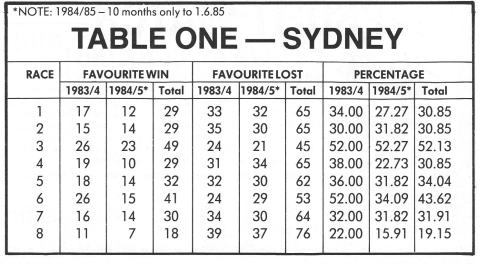
In Table 1, covering Sydney Saturday races run over almost two full years, we see that races 3 and 6 had high win-strike rates by the favourites - 52.27 per cent for race 3 and more than 43 per cent for race 6. As a generalisation, neither of these races are used for exotic betting.
But look at race 4 in Sydney - usually the Extra Trifecta race - and you'll see that only 22.73 per cent of favourites won.
Usually, the main quinella race is Race 8 in Sydney. Its strike rate for favourites was a paltry 19.15 per cent!
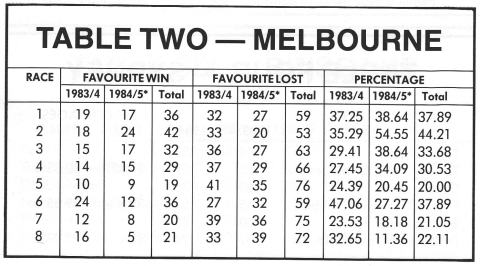
Now we look at the figures revealed in Table 2 covering Melbourne metropolitan meetings. It is here that we uncover some real drama and bizarre statistics.
The Sydney TAB usually conducts the Extra and Main Trifectas on Races 5 and 7 at Melbourne meetings. Now, bearing in mind that national favourites win strike of 33 per cent, we see that the favourite won the Extra Trifecta race in Melbourne exactly 20 per cent of the time, while the favourite in the Main Trifecta race managed to win only 21.05 per cent of the time.
In the usual Main Quinella race the 8th - the favourites' winning strike was only 22.58 per cent.
We looked more closely then at the figures for actual Trifecta, Extra and Daily Doubles, and Main Quinella races in Melbourne and Sydney and came up with the following figures.
MELBOURNE
| TOTAL races surveyed | 768 |
| WINNING favourites | 236 (equals 30.73 per cent) |
| EXTRA and Daily Double races | 380 |
| WINNING favourites these races | 103 (equals 27.11 percent) |
| EXTRA and Main Trifecta races | 183 |
| WINNING favourites these races | 36 (equals 19.67 per cent) |
| MAIN Quinella races | 93 |
| WINNING favourites | 21 (equals 22.58 per cent) |
SYDNEY
| TOTAL races surveyed | 757 |
| WINNING favourites | 259 (equals 34.21 percent) |
| EXTRA and Daily Double races | 376 |
| WINNING favourites these races | 117 (equals 31.12 per cent) |
| EXTRA and Main Trifecta races | 188 |
| WINNING favourites these races | 56 (equals 29.79 per cent) |
| MAIN Quinella races | 94 |
| WINNING favourites | 18 (equals 19.15 per cent) |
BRISBANE
| TOTAL races surveyed | 725 |
| WINNING favourites | 256 (equals 35.31 per cent) |
| EXTRA and Daily Double races | 362 |
| WINNING favourites these races | 110 (equa Is 30.93 per cent) |
| EXTRA and Main Trifecta races | 174 |
| WINNING favourites these races | 54 (equals 31.03 per cent) |
| MAIN Quinella races | 85 |
| WINNING favourites | 31 (equals 36.47 per cent) |
The above facts appear to substantiate that there is a case to be made out that manipulation is being conducted on the Melbourne TAB's Trifecta events and that both Sydney and Melbourne Main Quinella races are being manipulated.
Also, there could be a case for an investigation of manipulation of other "exotic" races in Sydney and Melbourne.
Statsman believes that if the races are not being fixed, then a clever group is at work manipulating the win odds and cashing in on the "exotic" pools. The total take could be tens of millions of dollars a year.
The funny thing is that the races where the favourites are winding up with poor winning percentages are usually good class events like open handicaps or welters, usually considered by experts to be easier races than any others to determine winning contenders.
Can there be a rational reason why the favourites are having such a poor run in these important exotic-bet type races?
How can the public be so wrong?
Why is it that in the Melbourne Extra and Main Trifecta races the favourites are only winning little over 19 per cent - compared with the national average of 33 per cent? It certainly makes us wonder - and no doubt, you, too.
We do not suggest with 100 per cent confidence that what we speculate is fact. We do put it forward as a very likely reason for the demise of so many favourites in such important betting races.
If anyone can come up with other conclusions we. would like to hear from them. We'll gladly publish their ideas.
Meantime, Practical Punting will continue to monitor these races to determine if the pattern is continuing. later, we will publish a considered system to take advantage of the strange facts we have outlined.
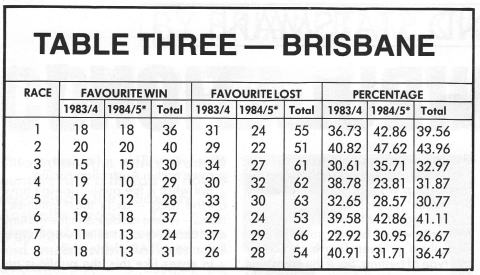
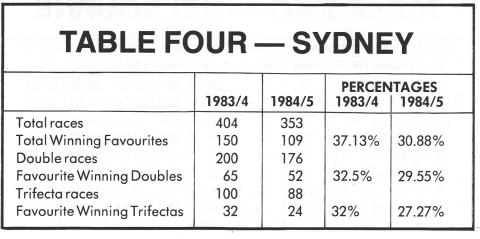
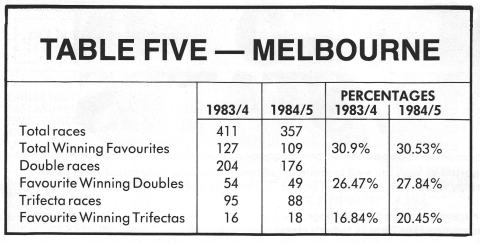
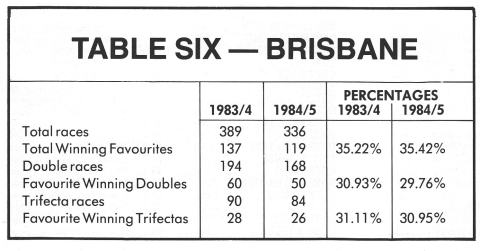
Click here to read Part 2.
By Brian Blackwell and Statsman
PRACTICAL PUNTING - AUGUST 1985